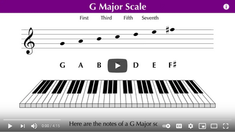Recognizing Chord Inversions
It is important to mention that some people often confuse the identity of a chord with the shape that it takes on their instrument. However, a chord is more accurately identified by the notes which are being played.
For example, the notes of a triad are derived from the first, third, and fifth scale degrees of a corresponding Major or minor scale.
Looking at the notes of a C Major scale we can see that the letter names which compose a C Major triad are C, E, and G.

However even if these letter names were to be rearranged, so long as the notes C, E, and G are being played it is still considered to be a C Major triad.

To summarize, a group of notes do not have to take a particular shape in order to be classified as a chord so long as the correct letter names are being played.
Root Position
When the root note of a chord is in the bass, meaning when the note with the same letter name as the chord is being played in the lowest vibrational frequency relative to the other notes, that chord is considered to be in root position.
Now, as we just learned, it does not matter what order the remaining notes of the chord are in. As long as the root note is in the bass the chord is still considered to be in root position.

First Inversion
An inversion in music occurs when the notes of a chord are rearranged so that the root note is no longer in the bass.
A chord is considered to be in first inversion when the third of the chord is in the bass.
Looking at the notes of a C Major scale we can see that the third scale degree is the note E. Therefore, if the note E is in the bass when playing a C Major triad, then the chord is considered to be in first inversion.
Again, it does not matter what order the remaining notes are in. If the third of the chord is in the bass it is still in first inversion.

Second Inversion
Second inversion occurs when the fifth of the chord is in the bass.
The fifth scale degree of a C Major scale is the note G.

Therefore, a C Major triad in second inversion occurs when the note G is in the bass.

Third Inversion
In certain situations the seventh scale degree may be added to the notes of a triad.
For example, the seventh scale degree of a C Major scale is the note B.

When the note B is added to the notes of a C Major triad the combination of notes is called a C Major 7 chord.

When the notes of a C Major 7 are rearranged so that the note B is in the bass that chord is considered to be in third inversion.
Now again, just like all of the other inversions discussed in this video, it does not matter what order the remaining notes are in. As long as the seventh scale degree is in the bass the chord is in third inversion.


